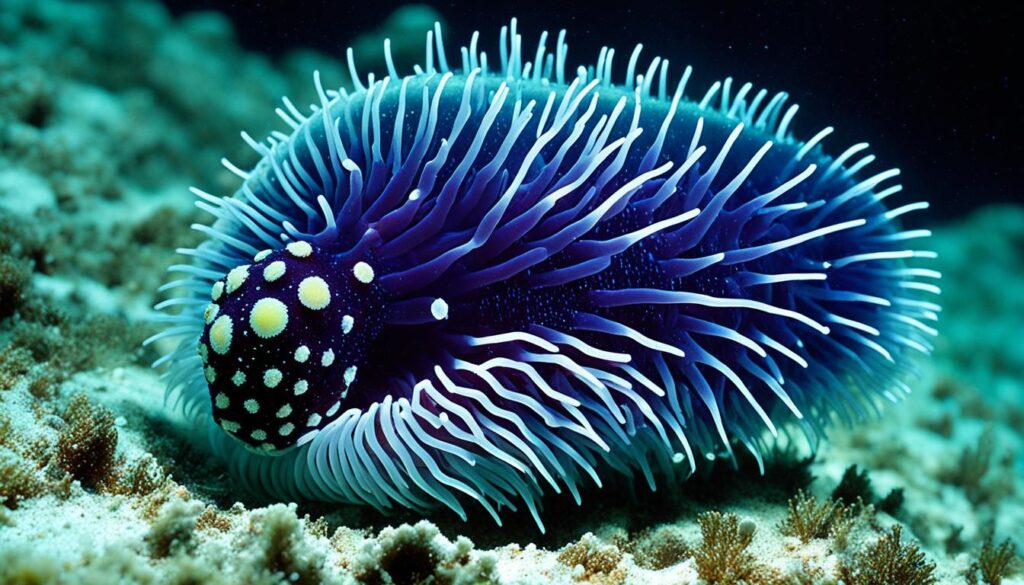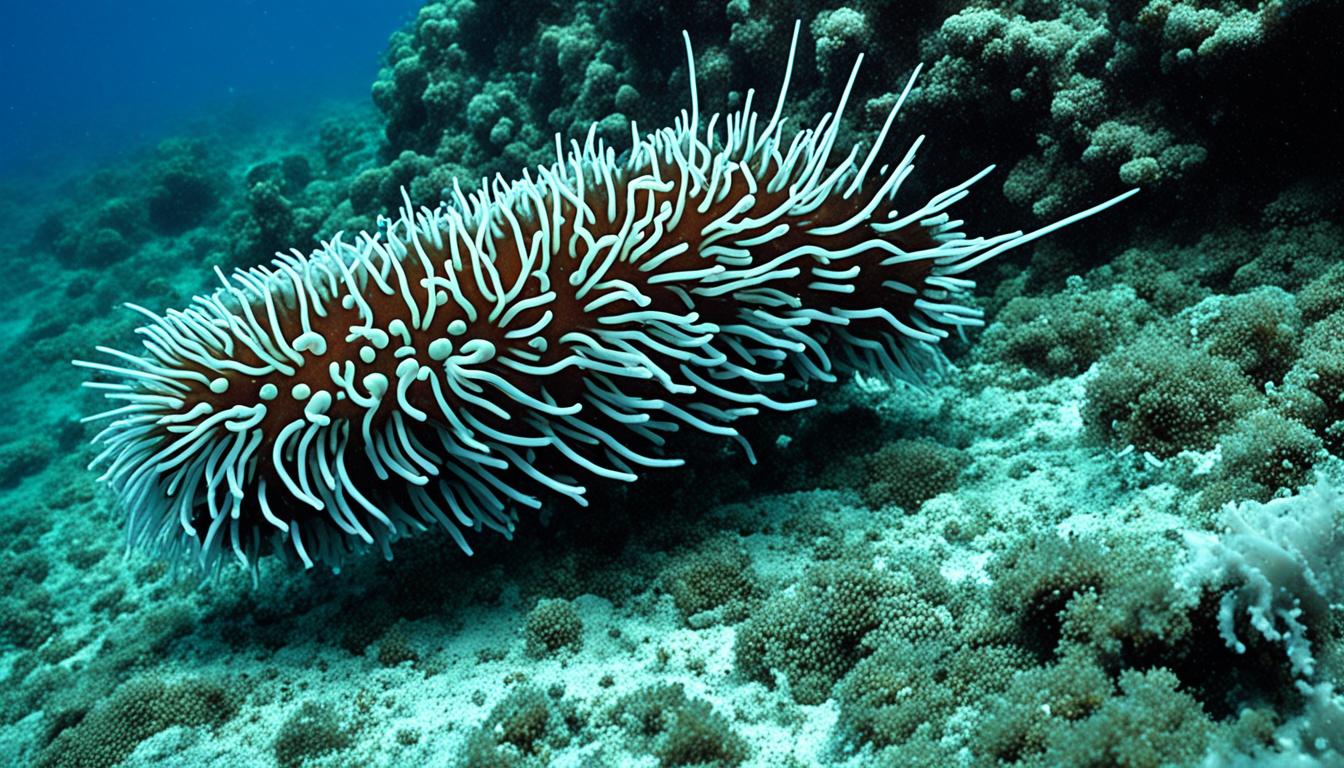Sea cucumbers seem soft and slow, but they have amazing defense strategies. These strategies help them survive in the tough ocean. They use chemical warfare and can even regrow lost parts. This shows how they protect themselves from predators and diseases.
This article will explore the ways these creatures stay safe underwater.
Introduction to Sea Cucumbers and Their Vulnerabilities
Sea cucumbers are fascinating creatures that live on the ocean floor. They are soft-bodied marine animals that help clean the ocean by eating organic matter. Their life on the ocean floor puts them in danger, making it important to know what they face.
These gentle creatures have many vulnerabilities that affect their survival. They move slowly and don’t have a hard shell, making them easy prey. Fish, crabs, and starfish hunt them because they can’t defend themselves well. They also face threats from toxic bacteria in their homes.
Learning about sea cucumbers’ vulnerabilities helps us understand how they survive. It shows us the special ways they defend themselves. This knowledge helps us see how these scavengers live in the ocean and how they’ve adapted to survive.
How do sea cucumbers defend themselves?
Sea cucumbers have developed ways to protect themselves from threats. They use chemical, physical, and behavioral tactics. These methods help them survive in their underwater world.
Overview of Defense Mechanisms
Sea cucumbers have many ways to defend themselves. They use:
- Chemical defenses like releasing saponins
- Physical defenses with the Cuvierian organ
- Behavioral adaptations, such as hiding or burrowing
Importance of Defense Strategies in Their Environment
These defense strategies are important for more than just survival. They help keep the balance in their homes under the sea. By keeping predators away, sea cucumbers help the whole marine ecosystem stay healthy.
This makes understanding their defense behaviors key to seeing how marine life is connected.
Chemical Defense: The Role of Saponins
Sea cucumbers have a special way to protect themselves called chemical defense. They use something called sea cucumber saponins, which are powerful compounds. These saponins keep predators away and help keep their home balanced.
What Are Saponins?
Saponins are natural substances found in plants and sea creatures. They can make soap-like bubbles in water. In sea cucumbers, these substances are toxic to predators. Their special structure makes them very effective at keeping predators away.
How Sea Cucumbers Produce Saponins Without Poisoning Themselves
Sea cucumbers are amazing at making saponins without getting poisoned. They have special ways to make these toxins. Since they don’t have cholesterol, saponins don’t harm them. This lets them make saponins for defense without hurting themselves.
Visceral Regeneration: An Evasive Strategy
Sea cucumbers have a special ability called visceral regeneration. This helps them defend against threats. When they feel danger, they can push out their guts as a trick. This trick helps them escape and shows how tough they are.
How the Expulsion of Guts Works
When sea cucumbers are stressed, they can lose their intestines. This distracts predators, giving them a chance to run away. It might seem drastic, but it’s a smart move to stay alive. The lost guts can even distract the predator long enough for the sea cucumber to escape.
Regeneration Process and Timeline
Right after losing their guts, sea cucumbers start to regrow them. They can rebuild their intestines in just a few weeks. This quick recovery is thanks to changes in their genes that help with regrowth. The way sea cucumbers can regrow their guts is a great example of nature’s clever ways to help animals survive.
| Stage | Description | Duration |
|---|---|---|
| Gut Expulsion | Shedding intestines as a defense mechanism | Immediate |
| Initial Recovery | Beginning of regeneration process | 1 week |
| Complete Regeneration | Full restoration of the gut | Up to 4 weeks |
Physical Defense Mechanisms: The Cuvierian Organ
The sea cucumber Cuvierian organ is a special defense tool. It helps sea cucumbers fight off predators. This unique feature lets them defend themselves in a unique way.
Introduction to the Cuvierian Organ
The Cuvierian organ is found in some sea cucumber species. When in danger, they can release this organ. It has sticky parts that help them defend against threats.
Function and Effectiveness Against Predators
The Cuvierian organ traps and stops predators. When released, its sticky parts stick to the predator. This makes it hard for the predator to move or escape.
This defense helps sea cucumbers avoid danger and escape. The benefits of this organ show its importance for their survival.
Behavioral Strategies for Survival
Sea cucumbers use many behavioral strategies to stay safe. These strategies help them along with their physical and chemical defenses. They react to threats in ways that keep them safe and let them live in different marine places.
How Sea Cucumbers React to Threats
Sea cucumbers have amazing ways to defend themselves when predators come near. They dig into the ocean floor to hide. This makes them hard to see and helps them avoid being eaten.
Some sea cucumbers also don’t move when they sense danger. This makes them even less visible and keeps predators away. These behaviors show how sea cucumbers can stay safe and hidden in a tough place.
Adaptive Strategies to Minimize Predation
Sea cucumbers also have special ways to avoid being eaten. These include:
- Burrowing into sediment for better camouflage.
- Staying still to not be seen during risky times.
- Using their surroundings, like rocks or coral, to hide.
These behaviors help sea cucumbers deal with dangers in their changing world. Their ways of avoiding predators are key to their survival. They show how marine life balances and adapts.

| Behavioral Strategy | Description |
|---|---|
| Burrowing | Sea cucumbers dig into the sea floor to hide from predators. |
| Staying Motionless | Remaining still to blend into the environment and avoid detection. |
| Environmental Utilization | Hiding among rocks or coral to enhance their camouflage. |
Predators of Sea Cucumbers
Sea cucumbers face many threats in the ocean. They have to deal with big fish, crabs, and even other sea creatures. Each predator has its own way of hunting, making the fight for survival complex.
Common Predators and Their Tactics
Sea cucumbers have many predators. Here are some of them:
- Larger Fish: Fish like triggerfish and pufferfish eat sea cucumbers. They use their strong jaws to remove the hard skin.
- Crabs: Crabs, with their sharp pincers, break apart sea cucumbers to get to the soft flesh inside.
- Other Echinoderms: Some starfish eat sea cucumbers, showing how echinoderms can be both predators and prey.
How Sea Cucumbers Adapt to Threats
Sea cucumbers have evolved to defend themselves. They use several strategies:
- Chemical Deterrents: They make toxic saponins to keep predators away.
- Visceral Expulsion: As a last resort, they can release their organs to escape, then regrow them.
- Physical Disguise: Some can change color to hide from predators.
The Ecological Importance of Sea Cucumbers
Sea cucumbers play a key role in keeping marine environments healthy and stable. They live on the seafloor, eating detritus and breaking down organic matter. This helps to recycle nutrients and boost the productivity of marine habitats, much like earthworms do in soil.
These creatures also keep the ocean floor clean, which is vital for many marine species. Their eating habits support a wide variety of life, making the ecosystem stronger. With sea cucumbers around, the ocean becomes a balanced place, full of different species that help each other.
It’s crucial to understand how important sea cucumbers are for our oceans, given threats like overfishing and habitat loss. We need to work on saving these creatures to keep our oceans healthy. By helping sea cucumbers, we help the entire marine world, which is good for our planet.










